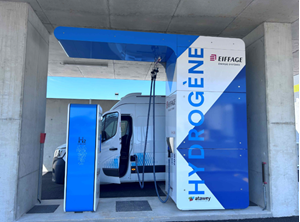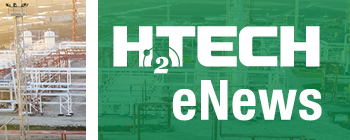News
Eiffage Énergie Systèmes builds a H2 vehicle station demonstrator in Vitrolles
Driven by the business development prospects offered by H2 mobility, Eiffage Energie Systèmes' Mediterranean division has embarked on building a H2 production and distribution station demonstrator. After completing the civil engineering work in 2024, their experts have now finished building the station's treatment, compression and distribution unit. The next step is to install the new-generation anion exchange membrane (AEM) electrolyzer, which will be able to produce green H2 from renewable energies for completely carbon-free mobility.
“DiH2” is an energy carrier used in its gaseous state under different pressures. Until recently, it has been produced mainly by petrochemical processes, through the steam reforming of gas. Now however, to produce “renewable H2”, a molecule of water (H20) can be broken down by electrolysis to extract two molecules of H2 (H) and one molecule of oxygen (O).
H2 can be stored without deterioration and burned without carbon emissions (in the steel industry, for example) or converted back into electricity using a process that reverses electrolysis. In this case, the yield is lower, but the reverse reaction releases only water. “H2 mobility is all about vehicles fitted with a fuel cell that mixes air and H2, converting the H2 back into electricity to drive an electric motor,” explained Business Manager Alexis Brosed Ponce.
Electrolysis, which boasts the advantage of zero CO2 emissions (unlike steam reforming), is the technology used in the H2 station demonstrator our experts are currently building. It is designed for mobility and will be able to refuel all types of H2-powered vehicles. “The demonstrator is a prototype in more ways than one and will be a first in our region. It will use a new-generation AEM electrolyzer technology. This "made-in-France" electrolyzer is an industrial prototype developed by our partner GEN-HY. It does not use rare earths and offers higher efficiency than other electrolyzers on the market," continued Alexis Brosed Ponce.
The ‘scale 1 model’ station demonstrator is to inject H2 into the fuel tanks of vehicles that will autonomously convert the gas back into electricity. It will take just five minutes to fill up a light vehicle with H2 (400 km to 600 km range). The H2 station is to be used as a showroom, enabling our experts to demonstrate their know-how in the field of H2 mobility. “Demonstration by example is also a good way of teaching and training our teams in this promising technology. Initially, the station will be able to supply the three utility vehicles that our agency is about to acquire, as well as vehicles belonging to interested partners, since it should produce 50 kg of H2 per day, enough to supply around ten light vehicles in all,” said Alexis Brosed Ponce.
The electrolyzer is to be powered by photovoltaic shades, to produce the “greenest” possible H2, and the vehicle fleet will soon be equipped with 2 H2-powered vehicles.


